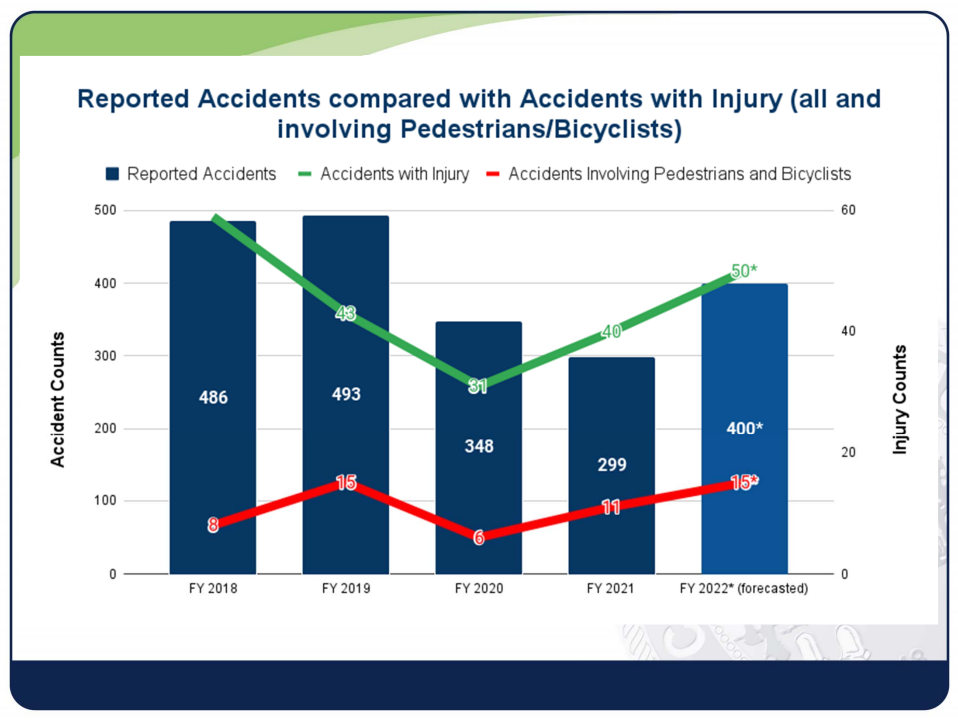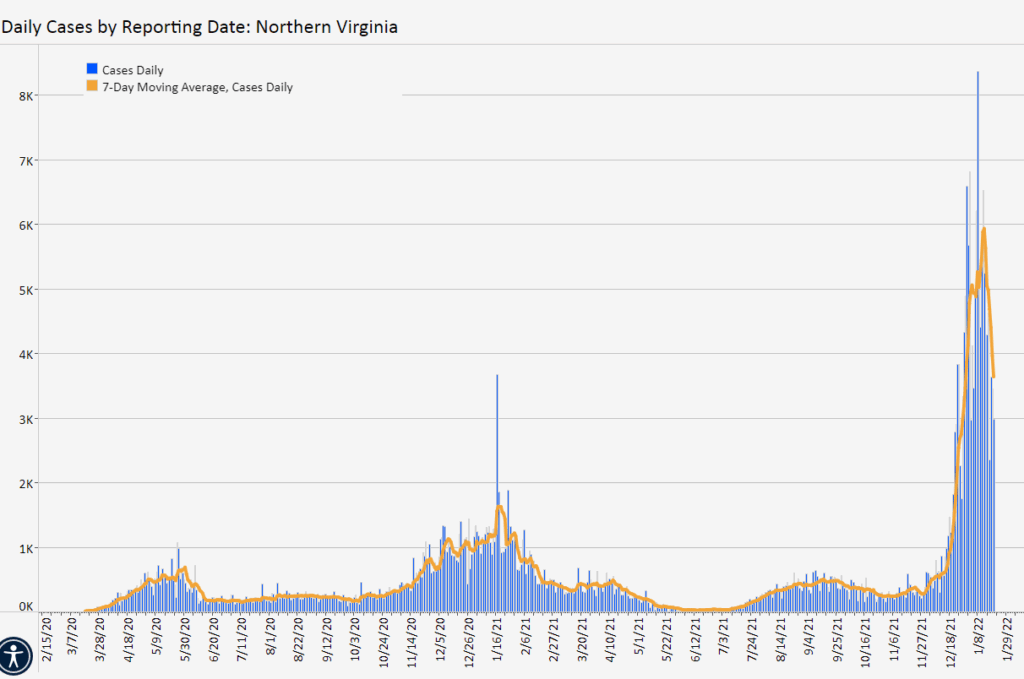Updates from Letty – January 21, 2022
Blog posts are the personal views of Letty Hardi and not official statements or records on behalf of the Falls Church City Council
Dear Friends,
Thank you for the kind notes and input on my draft priorities last week. One of the top needs I’ve heard is improved pedestrian safety/traffic calming/sidewalks. Good transportation intersects with all other areas of local public policy – equity, climate, housing, economic development – you can’t care about one without the other. Put simply, walkable places make great places. This is a timely topic. We did a 2+ hour deep dive on transportation safety in our work session this week. Our evolution from a car-oriented suburb to a more walkable, urban community has been slow and steady and remains one of our top priorities, but the pace of projects is currently constrained by resources. Budget season is around the corner, which is all about making sure we have resources and funding aligned against the community’s priorities. Read on to see what’s in progress and my thoughts.
I’m happy to hear what’s important to you at my virtual office hours next Monday from 12-1 pm.
Best,
Letty
PS – ICYMI, three more restaurants were announced at Founders Row this week.
What Happened This Week:
(1) Transportation Safety Deep Dive
Our discussion on transportation safety included the CACT, our volunteer board on all things transportation, and reports from the Police Chief on enforcement programs and Public Works on infrastructure projects. We can’t ticket our way into improved safety, so it’s important we build infrastructure and have safe street design as complementary tools along with enforcement.
Enforcement Efforts:
Despite reduced traffic volume due to COVID, accidents of all kinds, including ones that involve pedestrians and bicyclists are going the wrong way. This was not unique to Falls Church – 2020 was the deadliest year for driving in over a decade in the US.

Accordingly, the police have been stepping up enforcement with additional police units re-deployed to enforcement in the west and east ends of Broad St. You may have also noticed creative ideas like a parked empty cruiser on city streets to deter speeding. In the coming months, the Chief also shared there will be additional public awareness efforts like message boards and move-able speed trailers, but ultimately she will be looking to City Council for more resources. Letty’s thoughts: In addition to more enforcement, I would support adding additional intersections for red light cameras (we have two currently) and piloting speed cameras around school zones with the authority recently granted by Richmond.
Infrastructure vs Enforcement:
Some could argue that perhaps COVID has made drivers more aggressive and irresponsible – I also believe that the 2 years of lower car volume have simply unveiled the underlying issues with how our transportation infrastructure is designed. For example, straight, wide roads that allow cars to go fast – especially when they’re empty – are more dangerous. Enforcement alone won’t address safety – our infrastructure has to match.
Traffic Calming:
Since pre COVID, “clearing the queue” of Neighborhood Traffic Calming projects has been a priority. With additional funding, the backlog of NTC project has been addressed, with projects complete or underway across the city. Since January 2020, staff has worked on a total of 11 traffic calming projects, completing six projects and having two additional projects under construction and on hold due to weather. The remaining three projects are actively being worked. Addressing cut through traffic and speeding in the entire Greenway Downs neighborhood off Rt 29 will be the next most visible project in the coming years.
Sidewalks:
Connecting missing link sidewalks, adding new sidewalks, and fixing hazardous/inaccessible sidewalks are another top resident concern. Beginning with last year, we started funding sidewalks with dedicated operating budget dollars. This year, we also added in ARPA funding bringing the total budget to $300K, the largest to date. Staff has identified short stretches of missing sidewalks to be addressed. It’s important to note that sidewalks are more complex than they appear – often there are utility poles that need to be moved or undergrounded, easement issues, and potential impacts to the adjacent street parking. Letty’s thoughts – wide and accessible sidewalks is both a safety and equity issue. In addition to a staff driven program, I would love to see a bottoms up process where neighborhoods can petition for sidewalks, similar to the Neighborhood Traffic Calming program, and the work is prioritized after a certain threshold of the neighborhood is supportive.
Projects under construction or coming soon: S. Washington Improvements, S. Maple/S. Washington intersection, city-wide conversion to LED bulbs in street lights (will start with pilot neighborhoods to finalize brightness and temperatures), new HAWK signals on Broad
Other ideas: there are many ideas that can improve pedestrian safety without new infrastructure or concrete! Traffic signal timing is a proven and low effort solution – for example, LPIs (leading pedestrian intervals) are ped signals programmed to give pedestrians a head start in the crosswalk, traffic signals can also be timed to prioritize pedestrians first (the tradeoff is that car throughput is lower). In addition, I’d support exploring “no right on red” at especially high ped traffic and vulnerable intersections.
Proposed Roundabout / Traffic Circle
Finally we discussed a proposed traffic circle at the intersection of S. Maple and Annandale. They feel like an exotic concept, but they are well studied. This is a good source of information on traffic circles. There are more details to work out on how it may work in Falls Church, so more to come.
(2) Transitional Zones
We held our third work session discussion on how to facilitate smaller-scale, infill development in the city via Transitional Zones, or T zones. The existing T-1 and T-2 zoning districts are located between mixed-use development and low-density residential development, about total ~30 acres of land, or less than 3% of the total land area in the City. Most are relatively small and require consolidation for redevelopment. T zones are also primarily located in N. Washington and Park Ave, many with several long term uses – such as various churches and Kaiser – so available parcels that would be redeveloped is likely limited.
Staff heard majority support to come up with amendments to the zoning code to allow infill development in T zones with changes to allowed building heights, setbacks, and lot coverage. I expect we’ll see the detailed proposal in the next few months.
Letty’s thoughts: I support modernizing our rules for what can be built in T zones, especially because it can help catalyze smaller scale development to create an important balance in development scale. It also can be a mechanism to encourage “missing middle” housing types that haven’t been economically feasible to be built elsewhere. I think of T zones as the Goldilocks of zoning – not too big and not too small. It needs to transition nicely between taller, dense buildings in our commercial areas to residential neighborhoods. I’m also open to not requiring strict parking requirements or requiring ground floor commercial uses, especially where commercial uses may not fit or be successful. At the same time, I’d like to see affordable housing contributions and the gentle increase in density be offset with stormwater and tree canopy requirements, especially because the latter will help better tie T zone development into adjacent neighborhoods.
Examples of regional infill projects:
(3) COVID-19 – hopefully Omicron has peaked?
Have you already requested your free at home COVID tests? Need a test now? If you can’t find one locally, make an appointment at the new testing center opened in Fairfax by the Virginia Department of Health.
What’s Coming Up:
Monday, Jan 24, 2022 – Letty’s Virtual Office Hours (12-1 pm)
Monday, Jan 24, 2022 – City Council Meeting*
Monday, Jan 31, 2022 – City Council Planning Retreat
*every Monday (except 5th Mondays and holidays) at 7:30 pm at City Hall and livestreamed. You can access the agenda and livestream here, including recordings of past meetings